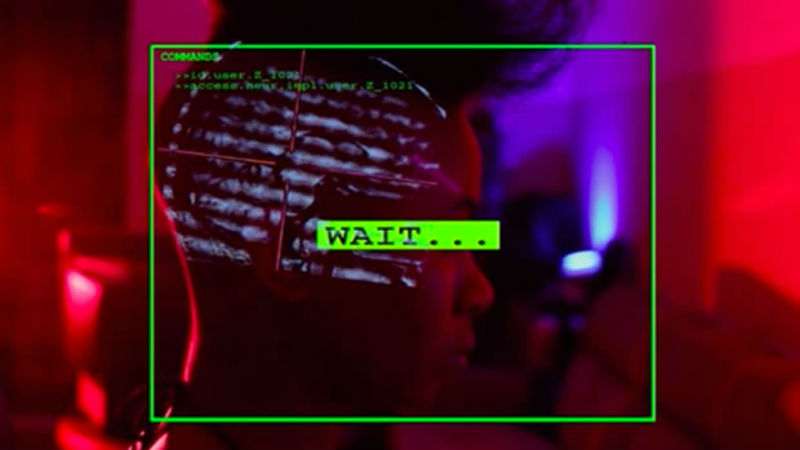Ever wondered what might happen if our neurological activity (including sexual activity) was recorded and stored digitally as neurocodes? Let’s push it further: have you ever considered the sexual possibilities around neurocodes, and indeed, the potential practice of neurosex?
Welcome to Neurosex Pornoia, a series of episodic shorts created by Berlin-based directorial/camera team Eric Pussyboy and Abigail Gnash. This project attempts to transpose Foucauldian ideas about biopower, surveillance and genealogical critique onto the queer post-porn sci-fi screen. It’s full of deeply disturbing eroticism that pushes you to reflect on patriarchal state subjugation of silenced sexualities. Unfortunately, the latest and longest installment, Neurosex3, a featurette at 40 minutes, doesn’t quite pull this off with the smart subtlety of its predecessors and has a tendency to confuse rather than confound. Nonetheless, there’s a natural knack for the nightmarish that packs a punch on both a visceral and cerebral level.

For those who haven’t watched the other Neurosex Pornoia episodes, here’s a quick recap. Neurosex1 sets up the concept of the neurosex code by showing two human subjects exploring oral bodily pleasures while hooked up to electrode pads in a lab. Neurosex2 introduces us to Z_1021 (Ze Royale), a human who feels frustratingly constricted by authoritarian behavioural control in a new biotechnological society and decides to illegally access a neurosex code. Both episodes are framed by archive footage of experimental lab-coated psychologists, a reminder of the unethical state-sanctioned practices that have historically ostracised ‘others’, informed theories of behavioural control and are often considered unethical. Although these episodes aren’t integral to understanding Neurosex3, they’ll certainly enrich your experience and are easy enough to watch at around 10 minutes each.
Neurosex3 brings us back to Z_1021 and – through a series of queer erotic vignettes – shows her initiation into the underground pleasure-seeking circle who previously uploaded a neurosex code to her brain. My own experiences of post-porn are largely restricted to Erika Lust’s ongoing XConfessions series. Neurosex Pornoia is far more radical than XConfessions. However, similar principles apply. Neurosex3 depicts consensual sex that respects all participants and is shot through a non-coercive lens, as opposed to the typical manipulation of the female body that is portrayed in contemporary conventional pornography. Importantly, any eroticism is continuously disrupted by DYCE’s expertly unnerving mechanical soundscape, which alienates the viewer from sexual arousal and subsequently re-politicises the sex.

And that’s not all! Eric Pussyboy and Abigail Gnash’s creation imagines a world in which women of colour, as well as individuals identifying as queer and non-binary, can inhabit whichever roles their personalities seek, rather than prescribed societal functions. Thus non-white characters can be protagonists and not simply the subject of orientalised desires. Queer characters don’t exist on the margins, but are given centre-stage in a dark erotic sequence where they exercise their free will through a series of neurosexual fantasies.
This is the essence of Neurosex Pornoia. It doesn’t just defy and transcend the normative boundaries of popular pornography. By setting up Foucault’s worst vision of state apparatus and the lab, it also doubles as a critique of a Western scientific method that has often harmed those genders, ethnicities and sexualities deemed abnormal by the power structures. This idea is realised to full shocking extent in one neurosexual fantasy where a character (literally) pisses over Carl Hagenbeck’s lethal orientalist legacy, with the help of sex toys symbolic of her queer agency.
Regrettably, Neurosex3 doesn’t quite dissect in as clear and subtle a fashion as the two prior episodes. This is undoubtedly dirty cinema, but at times its plot doesn’t quite follow and dialogue feels stilted. While non-linearity and unconventional delivery can also position artistic work beyond the normative, in the case of Neurosex3 it leaves more unanswered questions than its interrogative approach necessitates.
In popular terms, this entertaining short takes the ideology of the TV series The Handmaid’s Tale into sexualised Blade Runner territory, and the outcome is a very dirty mix. For this non-initiated hetero at least, Neurosex3 serves as an enticing introduction to the boundless creativity of the queer fringe.
Neurosex3 is showing as part of the Fringe! Queer Film Fest taking place right now. Click here for the film trailer.








